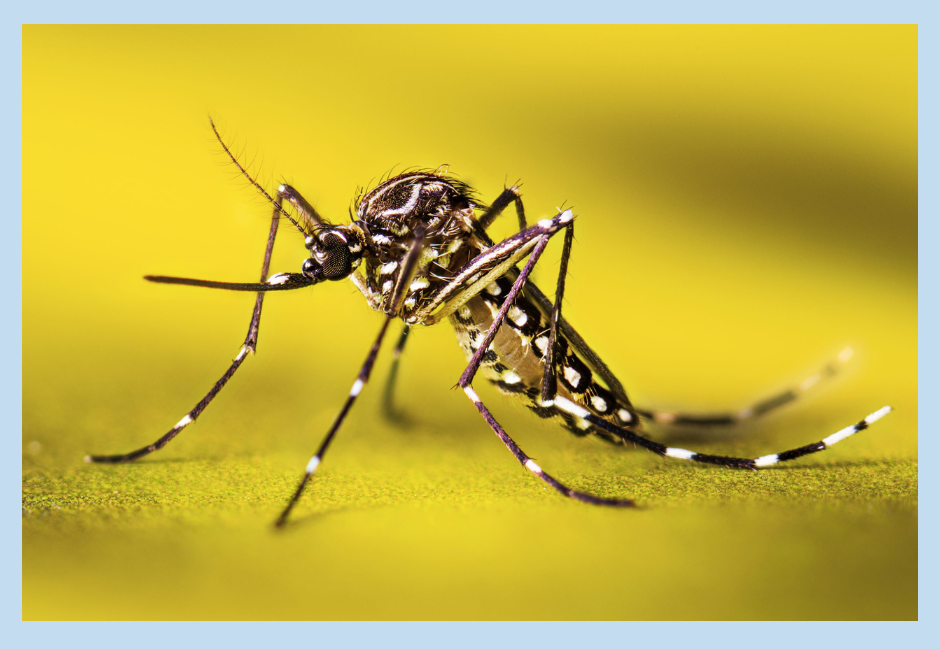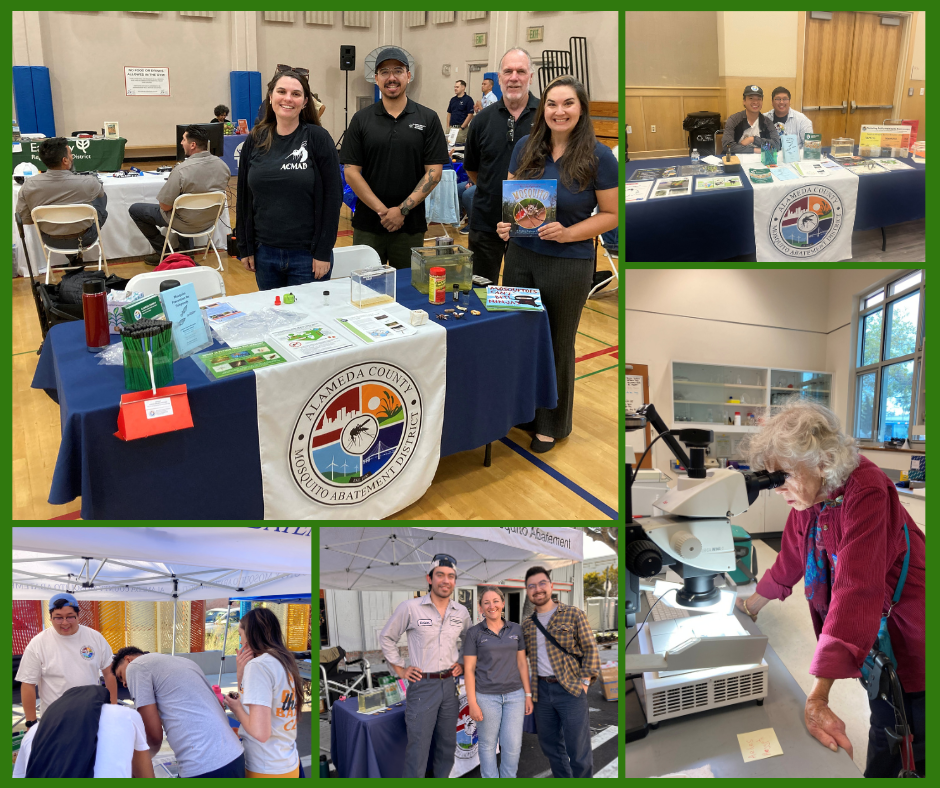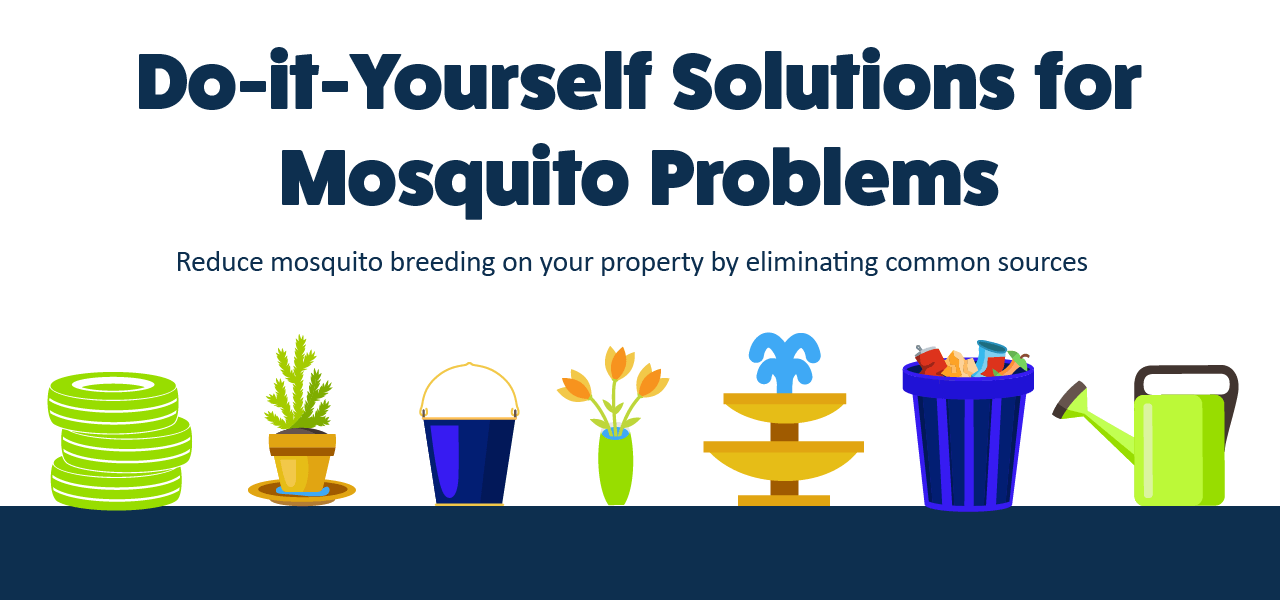Fall 2025 Newsletter
"It's Here." Aedes aegypti in Alameda County

This fall our office has been extremely busy with multiple Aedes aegypti detections, primarily in Livermore, but we also found the invasive mosquitoes in Dublin, Pleasanton and Fremont. After our detections in 2024 in Pleasanton, the District completed an internal assessment of how we addressed Aedes aegypti and what we needed to do to prepare for future invasive Aedes concerns. We learned a few things along the way, including that neighborhoods where neighbors talk to one another are easier to inspect, school districts are great at getting the attention of families, and people can accidentally spread Aedes eggs when they propagate plants. When we reflect on what we learned, we realized that many of our goals to prepare for Aedes aegypti were already in our 2024-2026 strategic plan.
Changes we have made in 2025 include:
- Hired Lizbeth Martinez, to the newly created role of Community Liaison, who leads our invasive Aedes response
- Held the first Invasive Aedes Regional Summit with multiple nearby mosquito abatement agencies
- Developed a new monitoring tool using PCR testing on suspected areas of mosquito breeding: Barcoding Quantitative PCR Assay to Distinguish Between Aedes aegypti and Aedes sierrensis
- Started a new partnership with UC Master Gardeners which enables the group to disseminate information to over 50 farmers markets in Alameda County: UC Master Gardener Program of Alameda County
- Deployed a multilingual AI bot, Ally that can answer questions about Aedes aegypti on phone calls and on the mosquitoes.org website
- Enhanced Aedes aegypti information on website: Aedes aegypti FAQs
- Modified classroom lessons to incorporate Aedes aegypti information
- Revised fogging notifications to include preventative larval treatments WALS in residential areas: Stay in touch
As we look into the future we recognize there will be more detections and more locations. We will continue to control all species of mosquitoes by focusing on catching mosquitoes during their larval stage. We will also continue to learn about new methods of control for aggressive daytime-biting Aedes aegypti. To keep Aedes aegypti in check we will need community support and engagement along with residents doing their part to remove or treat standing water.

Top left: Regulatory and Public Affairs Director Erika confirms the mosquito found in a trap is an Aedes aegypti mosquito. Top right: Community Liasion Liz speaks to the Pleasanton-Livermore CERT group about Aedes aegypti and the common locations they hide their eggs. Bottom right: Mosquito Control Technician Danny speaks to Dublin residents about common areas of standing water, particularly plant saucers. Bottom left: Lab Director Eric speaks with a reporter from KRON4 about the Aedes aegypti response and the traps we use to monitor for mosquitoes.
Events and Outreach
Our office has been busy spreading the word about mosquito prevention. This season we have been to new events and old favorites. Take a look at a few of them!

Top left: Public Education Officer Judith, Vector Biologist Erick, Newark Trustee Eric and Vice Mayor of Newark Eve attend the "Celebrate Heros" event in early October. Top right: Mosquito Control Technician Danny and Assistant Vector Scientist Eric attend the Livermore Resource and Volunteer Fair in August. Bottom right: A Master Gardener looking through the microscope to see the identifying features of Aedes aegypti. Bottom middle: Seasonal Technician Christian, Vector Biologist Sarah and Hayward Trustee and Councilman George attend the Downtown Hayward 3rd Thursday Street Party. Bottom left: Eric shows mosquito samples to Dublin residents at the first Friday Night Market in September.
Differentiating Aedes Mosquitoes in Alameda County

In Alameda County, we have both native Aedes sierrensis mosquitoes and non-native Aedes aegypti mosquitoes. When specimens are damaged and key identifying features are missing, the two species can look remarkably similar, making it difficult for our staff to distinguish them.
Both species lay their eggs one at a time, and although they typically prefer different breeding environments—Aedes sierrensis favoring organic-rich tree holes with amber water, and Aedes aegypti preferring containers near homes—their eggs can survive in a wide range of conditions. When residents report daytime-biting mosquitoes in areas such as the Berkeley or Fairview hills, it’s important for us to identify the species quickly, since each species requires a different control approach.
To address this challenge, our Laboratory Team, led by Vector Scientist Miguel Barretto, developed and verified a qPCR assay to detect mosquito DNA in water samples. This innovative test allows staff to determine whether mosquito DNA is present and, if so, which species it belongs to. Miguel tested and confirmed the accuracy of the qPCR assay using DNA from mosquito eggs, larvae, adults and from water samples, making sure the assay could reliably detect each species.
By collaborating with mosquito control districts across California, Miguel received samples of mosquitoes from locations as diverse as Orange County to Sonoma County. Miguel visited Butte County and located areas where Aedes sierrensis and Aedes aegypti are commonly found to validate the assay’s accuracy. This work took place alongside the lab’s regular mosquito monitoring and testing activities, as well as during the district’s initial detection of Aedes aegypti in Pleasanton in 2024.
Ultimately, the project was a major success. The district now has an additional tool to help detect and monitor Aedes aegypti populations, strengthening our capacity to respond quickly to new detections. We commend Miguel Barretto for his diligence and innovation. His results were published in Tropical Medicine and Infectious Disease under the title “Barcoding Quantitative PCR Assay to Distinguish Between Aedes aegypti and Aedes sierrensis.”
DIY tips to reduce mosquitoes
Residents who want to decrease their risk for mosquitoes on their properties have many items they can look for, from toys to tarps, there are many items that can hold enough water to produce mosquitoes. Review the list to find out where water may be hiding on your property. And thank you to Greater Los Angeles County Vector Control District for allowing our team to adapt their list. DIY Mosquito Prevention Tips

West Nile Virus update
In the Bay Area, we’ve seen very low West Nile virus activity among birds, mosquitoes, and humans this year. In total, only six West Nile virus–positive birds have been found in Alameda County. Contra Costa County and Santa Clara County are also reporting low numbers. However, West Nile virus activity has been increasing in the Central Valley, particularly around Visalia.
If you’re traveling to areas with higher West Nile virus activity, remember to limit outdoor exposure, wear long sleeves and pants, and use mosquito repellent.
West Nile virus is endemic in California—it often recedes and then flares up again. Residents are encouraged to keep their homes protected from mosquitoes by maintaining window and door screens in good condition and by inspecting for standing water, including areas such as sump pumps.

